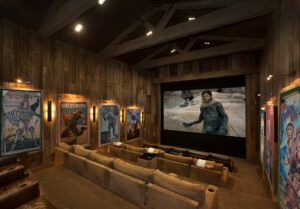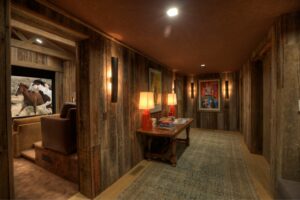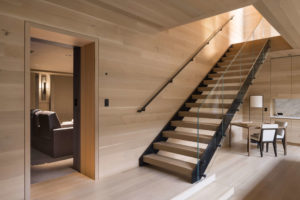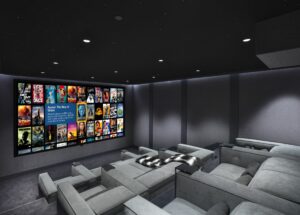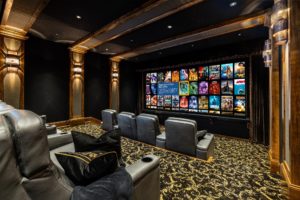Dune Dawns New Age of Sci-Fi Filmmaking
A Message from the Cinema Connoisseur
I recall reading Dune in high school a few years after its publication. I had discovered the science-fiction and fantasy genres and was drawn into the dramatically contrasting universes of the future and alternate past. In one aspect, I found reading Dune more akin to Tolkien. Both works achieved transforming alien landscapes into something real. I would emerge from reading either as if awakening from a vivid dream. Such an effect would be high praise for a cinematic experience!
Dune, the movie deserves that praise! To a great degree, it earns it through the work of largely unsung heroes of sound design, score, cinematography, and production design. All of whom rightfully won Oscars for their efforts! Join our Cinema Sommelier, integrator Todd Astill and supervising sound editor, Mark Mangini, for a scintillating tasting of scenes and unveiling of artistry. You’ll want to call up Dune on your Kaleidescape movie server and finish the dream!
Kaleidescape Curator Notes
The ongoing dilemma with works of originality is the slew of derivatives that follow. Repeated viewings of what was once breathtaking become commonplace with each iteration. The jaw-dropping use of “bullet-time” in The Matrix (1999) was such an innovative way to render action sequences that the effect was used in scores of follow-ons and even parodied in movies such as Shrek (2001), Charlie’s Angels: Full Throttle (2003), Kung Fu Panda (2008), X-Men: Days of Future Past (2014) and Deadpool (2016), to name a few.
Dune (titled onscreen as Dune: Part One) could have felt redundant in the same way – the hero’s journey of a teenage boy with special powers who joins an underdog cause to fight against impossible odds. We’ve seen that for decades in franchises such as Star Wars, Lord of the Rings, Harry Potter and countless others – including a previous iteration of Dune (1984).
But this latest version manages to do something unique: director Denis Villeneuve has created a work that feels both familiar and new. As a result, even novices to the complex storylines and characters of Dune can follow the action while appreciating the nuances of this futuristic, foreign universe.
Based on the 1965 novel of the same name by Frank Herbert, Villeneuve decided to split his adaptation into two parts, with part one debuting in October 2021. Following the success of the first film, Warner Bros. greenlit part two, which is scheduled to arrive in theaters Nov. 3, 2023.
Dune stars an impressive ensemble cast of actors, including Timothée Chalamet, Rebecca Ferguson, Oscar Isaac, Josh Brolin, Stellan Skarsgård, Dave Bautista, Stephen McKinley Henderson, Zendaya, David Dastmalchian, Chang Chen, Sharon Duncan-Brewster, Charlotte Rampling, Jason Momoa and Javier Bardem.
Preferred Pairing:
The Syrahs from France’s Northern Rhone region of Côte-Rôtie, or “roasted slopes,” have elements of sand, spice, and devastation – key themes in Dune – making it the perfect pairing. Like the noble House Atreides (which traces its history back to Agamemnon of Greek mythology fame), wine has an ancient origin in Côte-Rôtie, with records showing Romans cultivated the area for grapes two millennia ago during the reign of Caligula. But devastation struck during the second half of the 19th century when a microscopic insect called Phylloxera nearly wiped out winemaking in France. The only solution (still in use today) was to graft European vines onto American rootstock, which was naturally resistant to the insect. The best wines from Côte-Rôtie are made from a combination of grapes grown in both sandy soil (“blonde”) and darker, iron-rich dirt (“Brune”), a fitting match for our main character’s coal-colored hair and desert prominence.
When to Consume:
Dune is a slow-burn to savor when the sci-fi bug hits you. So, decant a bottle of Côte-Rôtie, enjoy the changing complexity of the Syrah, and sip your way through Part One of Dune. Oh, and common descriptors for the wine’s flavor profile include smoke, leather, and spice!
Body of Work
Dune is essentially a space opera. Its sweeping narrative unfolds across three planets and involves warring noble families, a sect of mystical witches with special powers, indigenous fighters overthrowing foreign powers, a prophecy about a coming “chosen one,” and of course, giant sand worms.
The movie seamlessly combines action, drama, fantasy, and sci-fi. The movie tracks the rise of Paul Atreides as he battles for control of the desert planet Arrakis. That world, also known as Dune, is valuable because it’s the only location in the universe with a special spice that, when mined from the sand, extends life and powers faster-than-light intergalactic travel. This makes Arrakis tremendously valuable not just monetarily, but politically as well.
The events of the movie are set in motion when the galaxy’s emperor removes ownership of Arrakis from House Harkonnen and gives the spice-mining duty to House Atreides, Paul’s family. The move wasn’t meant to give House Atreides a gift, but to create conflict between House Atreides and House Harkonnen, inevitably leading to a war over the planet. The Arrakis locals, fierce warriors known as Fremen, are mere pawns caught within these machinations, but become an important element to the story.
Sci-fi movies have sought to transport audiences to “strange new worlds” since the birth of the genre in 1902 with Georges Melies’ A Trip to the Moon, and they haven’t lost their allure, as evidenced by blockbusters like James Cameron’s Avatar: The Way of Water. What better use of movie magic than to empower an audience to experience something completely outside reality? Villeneuve’s Dune, however, joins a growing variety of sci-fi films that seeks to make the imaginary feel real to audiences. Villeneuve tasked himself with creating worlds that look as authentic as our own, and utilized natural light, real sets, and practical effects, instead of relying heavily on green-screens and computer-generated images.
Take the scene where House Atreides rescues spice miners from an Arrakis worm attack. The blend of industrial machinery with the enveloping sound of a sandstorm, the helicopter-like ornithopters, and the ensuing disorientation (all brought to life by Mark Mangini, Theo Green and their team of sound designers), feel as realistic as scenes in Black Hawk Down.
The subsequent desert skirmishes between Paul and the Fremen, and later against House Harkonnen, recall battle scenes in Lawrence of Arabia. Villeneuve didn’t seek to create bold new worlds for the audience to explore; he emphasized the natural features of earth-bound locations, brought to life by HDR.
The soundtrack is where the alien ambience of Dune dazzles. For a long time, sci-fi movies employed popular rock bands to provide the music for their films: the original 1984 Dune brought on Toto to score the soundtrack; 1980’s Flash Gordan had Queen; and Daft Punk did 2010’s Tron: Legacy. Hearing music so modern often has the effect of pulling the viewer out of the fantasy displayed on the screen. In contrast, Zimmer pursued sounds that would surprise the audience as foreign and unfamiliar, so he invented new instruments and played with computer-augmented human voices.
Our goal for Dune was to sonically rethink the sound of Science-Fiction. How would we avoid the tropes, conventions and sonic hyperbole associated with this genre and still respect and make it interesting?
Mark Mangini
These sights and sounds that are both real and augmented, native and alien, birthed a movie that is sui generis – grounded, yet strange and new.
Epic and intimate, Dune tames a notoriously complex sci-fi fantasy, providing the audience with gorgeous scenery as well as moving character portraits. With an otherworldly score by Hans Zimmer, Dune possesses the viewer’s senses completely, creating a fresh visual and auditory experience unlike anything else the audience has seen before.
Tasting Notes
Like fine wine, there are always moments that shine in a movie, scenes that stand out in our A/V sensory palate. For Dune we asked Todd Astill, President of Nerve Inc., to walk through the demo scenes in this movie to share some dealer “demo notes” and personal insights. He often uses the following scenes to showcase the latest A/V gear, ensuring the technology delivers an optimized performance.
According to Todd, “Dune’s filmmaker and production team understood that the goal was to transport audiences to another place and evoke emotion through the shared experience of that journey. No higher praise can be said about their work on Dune than you were there with the characters and felt the power of the story told through the cinematic experience.”
With that, let’s dig into some scenes from Dune: Part One.
A Test of Control: 00:23:33 – 00:28:15

As Paul Atreides is brought forth by his mother to meet with Reverend Mother Mohiam, it’s clear he is walking into a dangerous situation. “When his mother uses sign language to say, “remember your training, it is an attempt to prepare Paul for what is to come.” The scene is also a clever use of silence that sets the stage for Paul’s encounter with Mother Mohiam. Specifically, it introduces audiences to the power of the “Voice,” a manipulation of speech used by the Bene Gesserit to achieve complete control over a receiver. Mother Mohiam’s use of the “Voice” has Paul bowed down before her in seconds. With its many layers, the use of immersive audio delivers a startling sensation, putting you in Paul’s shoes as the “Voice” echoes through a cavernous space enveloping the audience.
This was one of our earliest challenges, to create the ‘Voice’ that the Bene Gesserit uses to control others. Notice that as we enter the scene the atmospheres subtly quiet down as if Mother Mohiam had control over the laws of physics. When she deploys the voice, it is accompanied by a ‘cloud’ of ethereal voices along with hers that imply a summoning of powerful ancestors as allies to give her power and stature.”
Mark Mangini
Paul is quickly put to the test. With a poison needle at his neck, he is required to put his hand in a box. If he removes it, Mother Mohiam will kill him. The marriage of sound and image comes together beautifully during this sequence. Flashes of visual and auditory sparks provide glimpses into Paul’s inner struggle with his fears and perceived pain. When the pain begins, a searing sound effect offers the audience an excruciating taste of Paul’s pain. In 4K UHD HDR imagery, his hand contorts, and you see every glistening of sweat on his face. In a vacuum of visual interest, the textures of cloth and flesh become interesting and potent, providing a powerful representation of his internal struggle.
The use of HDR and color plays another role as the camera cuts between Paul and his mother’s real-time reaction to the situation. The shots bounce between the warm amber filter of his mother to the cold blue/white color filter of Paul. The flash sequences in between represent a melding of warmth and finally triumph as he passes the test.
Saving the Miners: 01:02:32 – 01:08:12
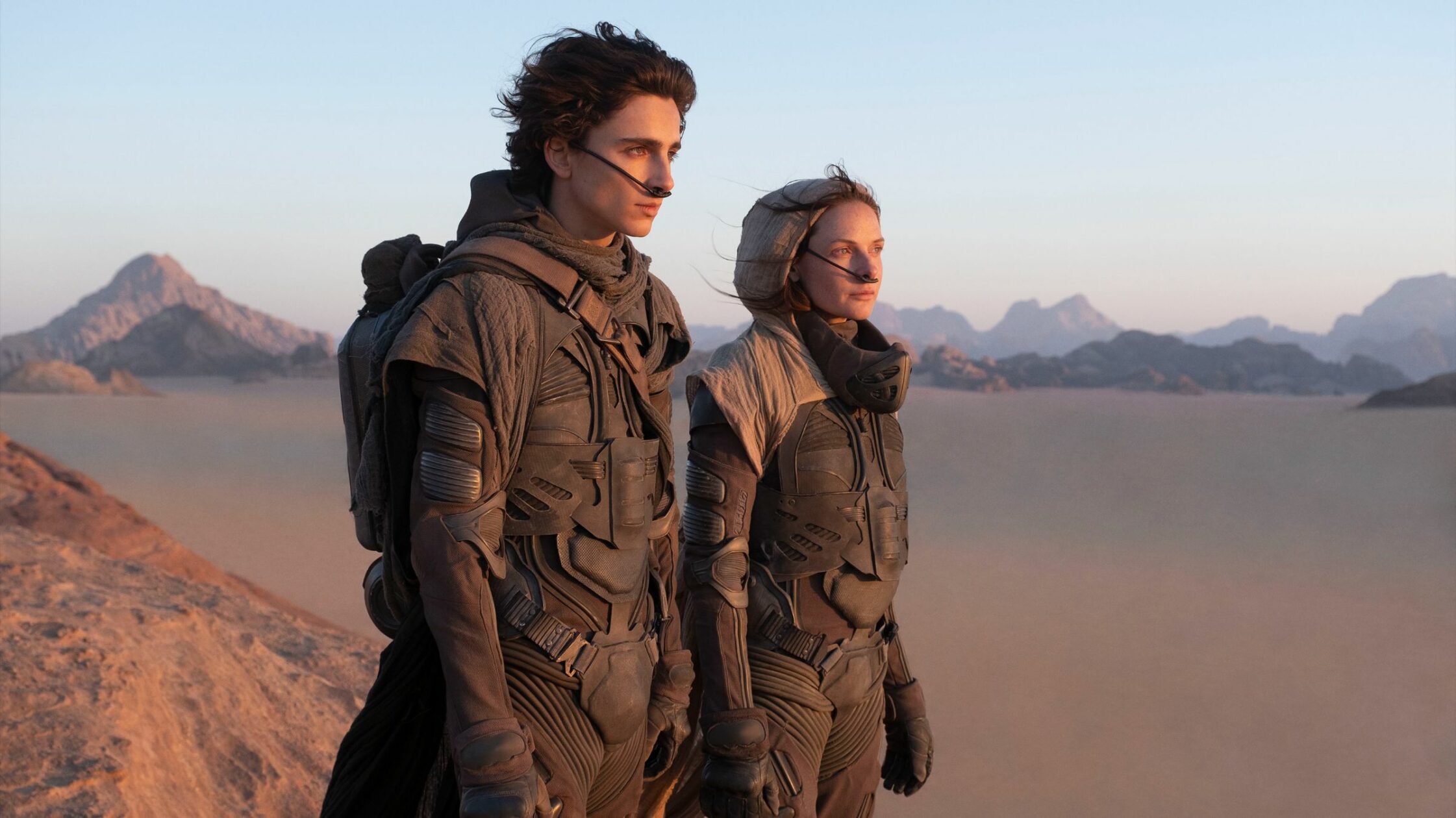
This beautiful cinematic 4K UHD HDR scene with its acutely detailed immersive sound is a reference demo scene for showcasing the latest technology with lossless quality from Kaleidescape. The scene provides a stunning dynamic range of sound, from the whipping of sand to the rhythmic thrumming of the ornithopter, overlaid with the lower rumblings of mining equipment.
This sequence required some of the most complex sound mixing. It contained the incessant sound FX of ornithopters, mechanics, sand movements and swirling, earthquake rumbles, and worm tunneling coupled with a powerful score that built anxiety and peril.”
Mark Mangini
As we enter the scene, awash with light, subtle tones of tan and white force your brain to recalibrate to take in all the texture of the desert, suits, machinery, and human flesh as they blend together.
As the ornithopter glides in to pick up the miners, the use of Atmos delivers a convincing whooshing sensation as if you are flying through the desert air. With the ornithopters in position to gather the miners, the audience falls into a cone of silence as Paul’s senses are overwhelmed by spice entering his blood. The audience experiences the hallucinogenic effect through masterful sound design evoking emotions. Sparkle of spice in the air translates texture into flowing purpose and clarity, faithfully represented by beautiful 4K UHD HDR imagery.
From chaos to peace and introspection to urgency, Paul is brought back to reality by his protector, and the sea of texture and sound returns him to the inhospitable reality of the scene. The visceral soundscape swells relentlessly until we are surrounded, immersed in danger with the character.
As the ornithopter flies away and the equipment is consumed by the giant beast, the scale and grandeur of the planet and worm creature dwarf the creations of man designed for exploitation of its resources. Sound and image are used with perfection to deliver scale to the scene as we have never seen before.
Mark Mangini
As the ornithopter clears from danger and we look back at the desert we hear the roar of the worm swallowing the spice crawler into its maw. As no worms were available for me to record this sound, I duplicated it by placing a small microphone down my own throat and sucking air violently to create that roar. That sound was then slowed down and pitched down to add size and girth. We also added that into the subwoofer to make the desert shake.”
The Harkonnens Arrive: 01:18:53 – 01:22:10
Like so many compelling passages in cinema, the canvas on which the director (and cinematographer) paint is black. For Dune, with a majority of the film shot on a bright desert set, the Harkonnens’ arrival scene provides an opportunity to showcase how displays, projectors and screens perform with dark shadows and flares of light and color.
Flashes of blue shields against orange mushroom clouds are the only colors, but shadow detail and inky blacks inject visual interest into what would otherwise feel dark and flat without HDR. Plumes of flame light the scene and quickly retreat into dark. Flashes of spotlights and cannons reveal destruction on a scale rarely seen in cinema.
The HDR is done so well that it creates a 3D visual that transports the viewer to their alien world. This, underscored with devastating bass, bolsters every visual flourish of light for the audience. Finally revealed, the undercurrent of conflict intensifies as the Atmos soundtrack crescendos with the full scale of attack through ever more frequent impacts of visceral sound and blinding light.
This sequence is, once again, a challenge to mix because it has bold, anthemic music set against gigantic sounds of attack ships, explosions, and general havoc. Working for us was having very little dialog to clear out of the way of. It is quite literally a ‘wall’ of sound. One can hear the ornithopters take off in the beginning of the scene, made from beetle wings and cat purrs, among other things. The landing ships stuck on the tarmac creak and groan as they are destroyed using sounds of rending metal from beating up on garbage dumpsters and elephant screams.”
Mark Mangini

Vintner’s View
Every exceptional wine review brings a little something extra to the table – personal insights from the master winemaker or the team of vintners who helped deliver the final product. The artistry that goes into moviemaking deserves the same recognition. In this section of the review, we reference “film vintners” to bring added texture to the creation of the film’s artistic flavors.
We asked supervising sound editor and Academy Award winner Mark Mangini, who brought home an Oscar for Best Sound in Dune: Part One, to provide some artist insights.
Our goal for Dune was to sonically rethink the sound of Science-Fiction. How would we avoid the tropes, conventions and sonic hyperbole associated with this genre and still respect and make it interesting? We wanted our own approach, one that wasn’t Star Wars, at one end, and theremin warblings at the other. I’m a huge fan of the sonic universe Ben Burtt created for Star Wars. It is inventive, fantastical, and iconic. All attributes we felt didn’t suit Dune. We hoped to liberate the sound of Dune from a grand tradition in Science-Fiction by redefining it as something familiar and grounded, existing in an acoustic reality that was inhabited by fantastic things you’ve never seen or heard before but, nonetheless, sounded like you had heard before.
Mark Mangini
Arguably, in science-fiction, you should be hearing things that you have never heard before and, as such, buy license to use fantastic sound, however bombastic or implausible. If you see VFX of things you have never seen before, it follows that you should hear things you’ve never heard before. We felt that was too much latitude and too tempting, allowing us to go overboard, creating an implausible sonic universe that challenged the audience’s suspension of disbelief.
As we contemplated how to create our sonic ‘universe,’ Theo Green and I spent many hours trying to develop an overarching philosophy, something the team could use as a filter through which all sound could be heard; a way to measure if what we were creating fit the world we heard in our heads and the one Denis had mandated.
In one of our many discussions, Theo mused that what Denis wanted was a Science-Fiction film that, however implausible, felt like a documentary. And, from that simple observation, he postulated that what he wanted was ‘F.D.R.’ – Fake Documentary Realism.
The idea was simple. Build a sonic world that sounded like a documentary film crew landed on Arrakis and everything the audience heard is something a mic on a boom pole might have captured while filming. However fantastic the focus of the camera might be (ornithopters, worms, shields), the sound had to feel like you were actually there hearing it.”

